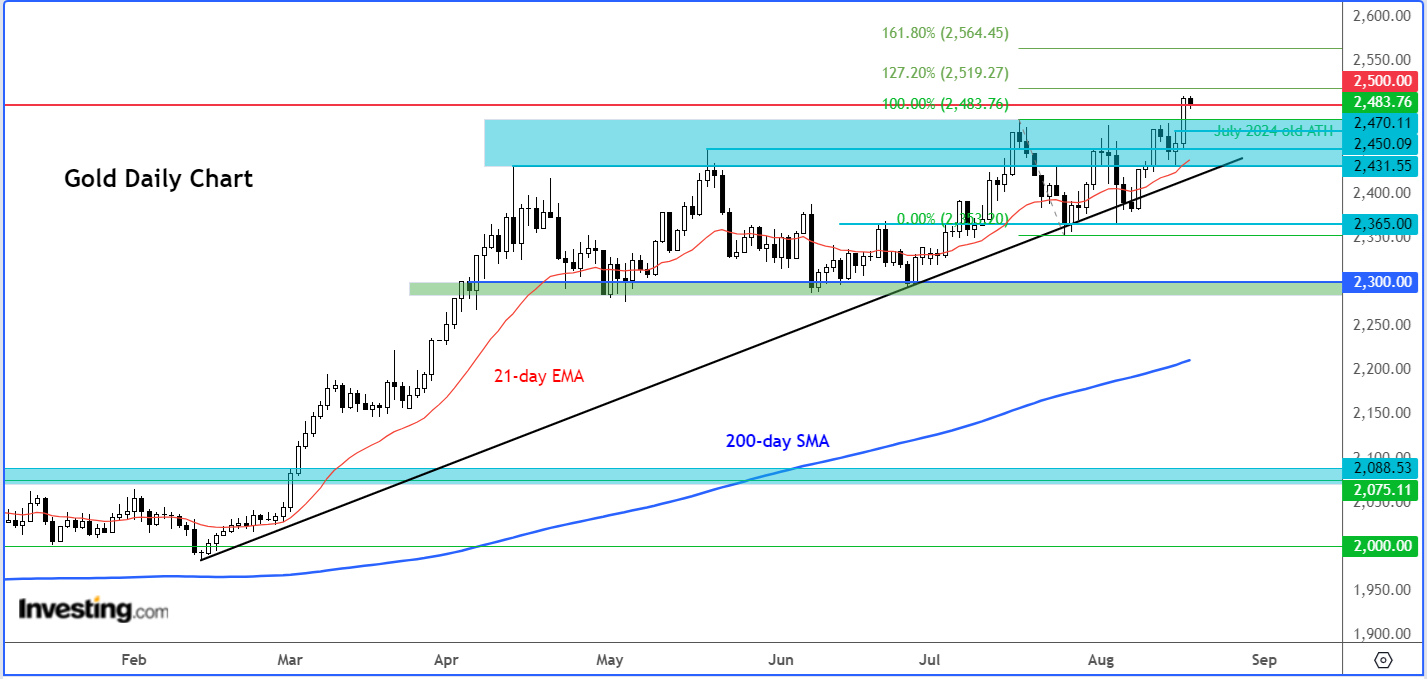- Gold could keep rising after hitting $2500, with bullish momentum supported by inflation hedging and weaker bond yields.
- A weak US dollar and potential Fed rate cuts could give gold prices further boost.
- Bullion traders should pay close attention to PMIs and the Jackson Hole Symposium this week.
- For less than $8 a month, InvestingPro's Fair Value tool helps you find which stocks to hold and which to dump at the click of a button.
As I have been banging on about it, gold finally reached the $2500 mark on Friday after a tight consolidation below it for several weeks. Despite trading sideway in early Monday trade, I believe the yellow metal is likely to climb higher and remain in a dip-buying mode.
For one thing, the underlying trend remains bullish, which is discouraging bearish speculators to step in without any signs of bullish exhaustions. For another, there are little fundamental justifications for short selling it just yet.
In fact, some would argue that gold remains undervalued given the big devaluation and loss of purchasing power fiat currencies have suffered across the world in recent years owing to high inflation, which is still going strong in some places.
Although the disinflation process is evident in the US and elsewhere, this is not to be confused with deflation. Prices are still rising, just not at the same pace as before. Inflation-hedging demand should still provide support for gold.
What’s more, the sharp drop in bond yields amid expectations of rate cuts by the Fed should benefit assets with zero or low yields on a relative basis.
Gold underpinned by weaker US dollar
The US dollar's recent weakness has also played a role in supporting gold prices.
Last week, despite stronger-than-expected US retail sales, jobless claims, and consumer sentiment, the dollar faltered due to weaker inflation figures and softer industrial production and housing data.
The Fed's focus is shifting more towards employment, with rising unemployment rate now at 4.3% outpacing its year-end target. This shift explains why the dollar has struggled to maintain its gains, as FX traders are paying closer attention to jobs data.
This week, though, the economic calendar is quieter, and it could be a long wait until we potentially hear something meaningful from the Fed and other central bank officials at the Jackson Hole symposium on Friday.
Looking ahead, the market expects the Fed to cut rates by about 100 basis points by the end of the year, with a 25-basis point cut likely in September rather than the previously anticipated 50.
Any strong indication of a September rate cut at the symposium could further weaken the dollar, providing additional support for gold.
Key macro events this week: Global PMIs and Jackson Hole Symposium
As mentioned, the economic calendar is quieter this week. The key event is likely to be the Economic Policy Symposium in Jackson Hole, Wyoming, on Friday.
The only exception being the global PMIs in mid-week. For US PMIs, the focus will be on services inflation and whether there is evidence of continued deceleration. A gradual slowdown supports the soft-landing narrative, but weaker-than-expected data—whether in headline figures, new orders, prices, or employment—could trigger a dollar sell-off as the market speculates on Fed rate cuts.
The Jackson Hole Symposium draws central bankers, finance ministers, and financial market participants from across the globe. The Fed has historically used this convention to signal major policy changes. Are we going to see the biggest hint yet that the FOMC will embark on a rate cutting cycle starting at their 18 September meeting?
Recent data showing stronger retail sales and jobless claims indicate that a 25-basis point cut at the September FOMC meeting seems more probable than a 50-basis point reduction that was priced in a couple of weeks ago.
However, given the Fed’s increasing emphasis on the labour market, the upcoming non-farm jobs report on September 6 will be crucial in determining the final decision. Still any strong hints of a cut in September at the Jackson Hole symposium could send the dollar lower and underpin gold.
Gold technical analysis and trade ideas
The higher highs and weakening selling pressure means bullish traders have been chipping away at prior sturdy resistance seen between $2450 to $2480 area. This area finally broke on Friday, triggering some follow-up technical buying that saw gold head to the next psychological level of $2500.
With that $2450 to $2480 area broken, this is now the most important short-term support zone to watch on any dips. Specifically, $2470 (Thursday’s high) is the level to watch within this zone.
Below this area, the next potential support levels come in at $2430ish – this being the high from April, where now we have the 21-day exponential moving average also converging with the bullish trend line that has been in place since February.
On the upside, with no prior reference points, Fibonacci extension targets such as those shown on the chart could provide objective targets for the bulls to aim for. Otherwise, watch round handles like $2600, $2700 etc., for potential resistance as people like to trade around round figures.
***
This summer, get exclusive discounts on our subscriptions, including annual plans for less than $8 a month.
Try InvestingPro today and take your investing game to the next level.

Disclaimer: This article is written for informational purposes only; it does not constitute a solicitation, offer, advice, counsel or recommendation to invest as such it is not intended to incentivize the purchase of assets in any way. I would like to remind you that any type of asset, is evaluated from multiple perspectives and is highly risky and therefore, any investment decision and the associated risk remains with the investor.
